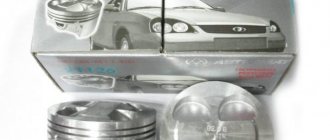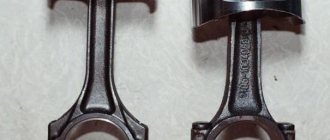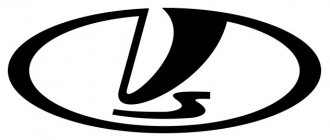A mechanic I know who works at a LADA dealer told me which engines are “plug-inless”
I have a Lada Granta 1.6 2022 model.
I bought it new and so far there are no complaints about the car. Recently I had to go for another maintenance. I usually go through it with a familiar master, and this time I did the same. While I was handing over the car, he said that it wouldn’t hurt to check the timing belt. The fact is that in 2022 there was a transition period. At this time, the plant moved away from engines in which the valves would bend when the timing belt broke. In their place came the so-called “plug-inless” motors. The master told me on which engines, when, by date and model, these changes occurred.
Subtleties of ShPG
Let's move on to the most interesting part - the connecting rod and piston group. On our plug-in engine, the pistons do not have grooves for the valves. We decided to replace the pistons with new ones, with grooves, and together with the connecting rods, since the old ones were bent. We ordered spare parts from the official dealer Federal Mogul. The kit for one cylinder includes a piston, rings, a pin and the connecting rod itself, along with bolts for securing the lower cover of its head. Grooves are visible on the bottom of the pistons, as well as the number 11189, an arrow indicating the direction of installation of the piston in the cylinder block, and the production date. The skirt has an improved iron oxide coating to protect it from damage.
The lower head of the connecting rod is made using breaking technology, due to which the joint is practically invisible. The bolts that secure the bottom cover of the connecting rod are tightened in two steps: first with a torque of 20 Nm, then turned by 135°. Protrusions on the bottom cover and on the connecting rod body help you navigate during assembly. On the bottom head of this spare part, on both sides, there is a marking duplicated in two places: the release date of the part and its batch number are indicated. All numbers must match.
Based on the diameter of the skirt, pistons are divided into three classes. We had class B pistons, so the new ones have the same class, as indicated by the corresponding markings on the parts. There is also a mark on the cylinder block - on the mating surface, next to the threaded holes where the engine sump is attached.
When purchasing spare parts, it is also important to consider the connecting rod weight class! This information is on the cover of its lower head. There are three such classes, and they are indicated by dots - one, two or three. The set must contain connecting rods of the same class or neighboring ones, for example, first and second, but in no case first and third.
After installing the piston group and tightening the connecting rod bolts, we install the aluminum pan. There is no need for a gasket here - just sealant. It is advisable to use an oil and petrol resistant composition. Only a small amount of sealant should be applied so that excess is not squeezed into the internal cavity.
Where it all started
Changes were required for several reasons. One of them was that on VAZ car engines, when the timing belt broke, the valve and piston struck. As a result, the parts seriously deteriorated and required repairs.
Such work is very expensive. This problem needed to be resolved urgently. Therefore, AvtoVAZ decided to make changes to the entire line of engines. The essence of the modernization was the installation of new pistons, with which such emergency situations could no longer occur.
The company that supplies engines to the plant was able to switch to the production of pistons with recesses in the bottom. Engines containing such parts began to be called “plug-inless”.
When the belt breaks, the valves do not “stick” into the pistons. This happens precisely because of the existing groove.
It is necessary to clarify that the majority of manufacturers...
....cars do not install such pistons on their power units, since they negatively affect environmental performance and reduce engine power.
Previously, the public was provided with information that engine 21179 would be modified and given the number 21178. This model will be able to produce 136 hp. With. Thanks to the use of variable length intake valves and dual gas distribution system.
The most powerful and expensive AvtoVAZ model that went into production, Vesta Sport, is equipped with a forced 145 hp engine. s, volume 1.8 l, 187 Nm of torque. The modified engine from the previous model has characteristic distinctive features - completely new camshafts with a different profile, in which the cam lift is increased. Also, the calibration of the controller has been worked out and the pressure in the fuel supply system has been increased.
In addition, in the winter of 2022, AvtoVAZ registered the not yet presented Vesta R. Presumably this model will be equipped with a forced 1.8 liter engine. and 180 horsepower. It was also previously reported that the domestic auto giant plans to increase the production volume of its own engines to record levels.
Share
Only the lazy would not blame the current AvtoVAZ engines for losing the ability to tolerate a broken timing belt without consequences. And now the plant has decided to return to a design with which “Stalingrad” does not occur if the belt breaks.
Where are the updated engines installed?
VAZ announced that new “plug-in” engines have been developed for a range of 1.6-liter engines. Such engines began to be installed on most modern models: Lada Granda, Kalina, Largus, Vesta.
As for 1.8-liter engines with the VAZ-21179 index, “plug-inless” engines are not provided for them. If we talk about Grant models, then new pistons are installed on both 8 and 16 valve engines.
Detailed information is known about the Vesta and XRAY models with 1.6-liter engines. All cars that left the assembly line after August 15, 2022 are equipped with special pistons with a groove that prevents their contact with the valves. The same applies to the Largus car series.
Detailed diagnostics: structural component of knocking
Guided only by the thermal signal, it will not be possible to find out exactly why the hydraulic compensators are knocking. An additional series of tests is required. Its essence lies in the analysis of changes in the acoustic design of the Vesta engine with changes in speed and taking into account the coolant temperature.
Operating with revolutions
The testing stages boil down to analyzing engine operation in various ways:
- Cold and hot shock that disappears at high speeds indicates wear of the ball valve of the hydraulic module or its clogging with wear products. Option No. 1: Replace the oil and oil filter with those suitable for the 129 engine. As a last resort, replace low-quality hydraulic compensators.
- The noise exclusively on a hot engine, which goes out as the speed increases, indicates a critical condition of a pair of pistons. Eliminated only by replacing the full compensator.
- Touch sounds are heard only at high speeds, regardless of engine temperature, and at idle the engine runs smoothly - keep an eye on the oil level. It is advisable to pour slightly above the average level of the rod, without exceeding the MAX mark. A damaged oil receiver has a similar effect.
Consequences of ignoring a fault
The main condition for troubleshooting is intrusive extraneous noise. Few people know what the actual risk of listening to is. Excessive timing clearances affect the behavior of the camshaft: the resulting shock loads significantly reduce the service life of the crankshaft.
From what date exactly should the countdown begin?
Of course, plant representatives indicated the exact start date for the changes. However, it is clear that completely rebuilding all pipelines is quite difficult. As the master told me, all cars starting from 2022 have “plug-in” engines.
But with 2022, things are not so simple. It turned out to be transitional and it is difficult to say exactly which engine is installed on the vehicle. A mechanic I know said that on cars produced in the first half of November, the engines are installed in 50/50 proportions - depending on your luck. However, there were also later models with the old type of engines.
The reason for this is simple. The fact is that production always has all the parts with a decent supply. And, of course, no one will just throw out outdated ones. Such engines continued to be installed in cars. And even AvtoVAZ itself will not be able to say when they ended exactly.
What about 1.8 liter engines?
It all depends on the demand for this modification. At present, potential buyers do not express a desire for such a change. However, this does not mean that it is impossible to obtain it.
The Lada brand development department said that in order to obtain a “plug-inless” engine, you need to write an official letter to the factory.
Thus, if you are the owner of a domestic car made in 2022 or higher, then you are guaranteed to have a “plug-in” installed.
Do you have anything to add? Write in the comments, perhaps this will greatly help readers in the future. Also subscribe to our channel in ZEN .
Source of the article: https://proautomasla.ru/stati/znakomyj-master-rabotayushhij-na-dilere-lada-rasskazal-kakie-dvigateli-bezvtykovye.html
AVTOVAZ modified 1.6-liter engines to prevent valve bending, new details
On modern VAZ engines, when the timing belt breaks, the valves “meet” the piston, which causes critical damage and requires expensive repairs. In this regard, AVTOVAZ decided to modernize the line of engines by installing new pistons that will eliminate such damage, writes CARscope.ru, citing its sources.
The plant's supplier, Federal Mogul, has mastered the production of pistons with recesses (holes, counterbores) in the bottom. Motors with such pistons are popularly called “plug-free”, that is, when the timing belt breaks, the valves do not “plug” into the pistons, the bottoms of which have special grooves for this case.
Technical parameters of engine 21129
| Index | Engine 21129-10 |
| Volume | 1596 cm3 |
| Phase shifters | No |
| Fuel octane number | 95 |
| Compression ratio | 10.5 |
| Max torque | 148 Nm |
| Environmental standard | Euro5 |
| Timing drive | Belt |
| Cylinder diameter | 82 mm. |
| Power | 106 hp |
| Cutoff | 6200 rpm |
| Engine oil class | SM, SN, SL |
| Hydraulic compensators | There is |
| Resource | 220 thousand km. |
Are all VAZ engines plugless? Here's what the official dealer said.
In September 2022, an official statement from AvtoVAZ appeared stating that all VAZ 1.6-liter engines are plug-inless. That is, if the timing belt breaks, the valves on the engine will not bend. Here is the answer on the official LADA page on VKontakte
LADA cars are equipped with engines with plugless pistons. These changes occurred in mid-July
This information was confirmed by the Lada resource. Online
.
On all LADA vehicles with a 1.6 LADA engine produced after 08/15/2018, the possibility of contact between the piston and the valve is structurally excluded
During my experiment to check the declared timing belt resource of 180 thousand mileage (the results can be read HERE
), I had to contact an official VAZ dealer to replace the timing kit. And what they told me threw me into a slight stupor.
I changed the timing belt not of my own accord, but because it broke. The car went to the authorities on a tow truck. And when the inspection master told me that we looked at the valve just in case, you’re lucky it didn’t bend, I countered with the information that I had. They say that since September there has been no connection, restyling and all that. To which I received an answer that, judging by their statistics on timing belt repairs, until approximately mid-November 2022, the engines were running in a 50/50 ratio. And no one can say what exactly the client purchased. My car left the assembly line on November 13, 2022 and I was lucky, it has a plug-inless engine.
Now, of course, all engines are plug-inless, but in the transition period of 2022 this is a big question. Judge for yourself, it’s impossible to switch to plug-free systems at once. This may be caused by a shortage of components, while warehouses are full, or simply by simple greed. Well, judge for yourself, you have pasta cones lying around at home and you suddenly decided to switch to spirals, won’t you throw the cones in the trash? Likewise, VAZ, while replenishing its warehouses with new components, was slowly using up the old ones. How long the old one lasted, as always, will remain a mystery.
Source of the article: https://zen.yandex.ru/media/ubijca_mifov/vse-li-dvigateli-vaz-bezvtykovye-vot-chto-rasskazal-oficialnyi-diler-605432833729ca110e7752aa
AVTOVAZ will release a 1.8 engine with “stickless” pistons, new details
From mid-July 2022, AVTOVAZ has changed the pistons designs of 1.6-liter engines. The holes in the bottom of the piston for the full stroke of the valves eliminate the possibility of sticking the valves into the piston if the timing kinematics are disrupted (for example, if the timing belt breaks). A similar modification will appear on 1.8-liter VAZ engines (VAZ 21179), which are installed on Lada Vesta and Lada XRAY. All information on this topic was collected by the Lada.Online website.
New teeth
Let's move on to the timing belt drive. We chose the Gates kit, which includes a Dolz pump with gasket, belt and pulley with semi-automatic tensioner. By the way, different devices are used for tension. We selected a crescent-shaped grip designed for the roller. The gripper is placed on the roller, a bolt is screwed to the head of the latter, and the belt is tensioned. We preferred a large set with a pump to be on the safe side: our car has 68 thousand km on it, and it is unknown how long the pump installed on it will last.
It was also decided to change the auxiliary drive belt - peeling appeared on the old one. We bought a Gates 6PK995 belt and a new INA pulley to replace the whistling old one.
Life hack: Lada Vesta plugless pistons - algorithm for replacement
The Lada Vesta currently has plugless pistons. They are needed so that if the belt breaks, the valve does not bend. STK pistons are installed on the vest. Special grooves prevent the piston and valve from meeting. New cars have a piston with grooves, but what about the early Vesta engines? On early cars, you can change the pistons to plugless ones. Lada Vesta has a modified piston group. It is light and strong. The piston of a Lada Vesta car weighs 242 grams.
Non-stick pistons on VAZ engines have become a long-awaited innovation for lovers of domestic cars. Even on the Priors, it was noted that if you do not pay proper attention to the timing belt, there is a risk of bending the valves if the belt itself eventually breaks. All new Ladas suffered from this problem, until in July 2022 VAZ began installing engines with “error corrections.”
As for the Lada Vesta, plugless pistons for the flagship of the Russian automobile industry have become a timely addition to the overall positive impression of the car. Vesta has been equipped with plugless pistons since July - this applies to engines with a displacement of 1.6 liters.
Independent work on the internals of the engine requires patience and accuracy. However, Vest drivers are already in a hurry to express their desire to change the “piston” to the Lada Vesta, so as not to have to undergo major repairs in the future if the timing belt breaks.
21129 engine and variable geometry intake
The intake has undergone a radical change; the intake manifold has a system of dampers, with their help the filling of the cylinders (with air) is regulated. A standard intake ensures the correct flow of air within a certain range of engine operation.
With the help of dampers 129, the engine is able to fully fill the combustion chamber. When the crankshaft rotates low, the air travels a long path. At high speeds in short.
Switching the operating mode is carried out by the control unit. Instead of the familiar mass air flow sensor, an absolute pressure sensor and an air temperature sensor are used.
What else does AvtoVAZ offer?
New AvtoVAZ models require environmentally friendly engines, this is another reason for creating the 21129 engine. The engine was adjusted to Euro-5 standards: they changed the intake, reduced the exhaust, added a Euro-5 catalyst, changed the firmware of the M86 ECU - ready. The engine was also adapted for various gearboxes.
- Renault gearbox (cast crankcase) volume 4.4 liters.
- RKP (stamped crater) with a volume of 3.2 liters.
Basic faults
After the problem with bent valves went away, the problem with knocking pistons remained. A knock occurs when its trajectory in the cylinder changes and it encounters some obstacle in its path. This may be due to insufficient oil level, excessive viscosity, or improper operation of the connecting rod.
A knocking noise starts when starting “cold”, but when the engine knocks when it’s already warmed up, it means that it’s definitely time to change the piston group. Don't forget to check the oil level in the internal combustion engine.
Everything's a head
Let's move on to the cylinder head. We replace all valves that are bent with new ones. To do this, we rub them in and check for leaks. Then we install the oil seals, and then the valves themselves. When removing the cylinder head, all gaskets are damaged and must also be replaced.
The gasket between the head and the block is especially important. It is two-layer, metal, with springy “zigs”, which ensure the tightness of the connection with a lower tightening torque. Thanks to this part, the volume of gases entering the engine crankcase is significantly reduced - this helps to stabilize its operation, and a lower tightening torque reduces deformation of the cylinder walls. Our motor uses M10 bolts, tightened in three steps: first with a torque of 20 Nm, then they are turned twice by 90°.
Replacing the piston group
Changing pistons in a Lada Vesta car is not easy - the engine itself weighs more than 100 kg, it will have to be taken out and disassembled. Before this, you will have to disconnect a lot of parts and connections from it, so it is better to carry out the work in a heated garage with a free zone. It will have to be made working in order to lay out the engine parts on it. Remove the engine from under the hood:
- Relieve pressure from fuel pipes. To do this, open the fuel pump hatch under the rear seats and disconnect the wiring harness from the fuel pump.
- When the engine stops, reconnect the connector, close the lid, and put the sofa back in place. Reset the minus from the battery.
- Remove all refrigerant from the air conditioning system.
- Remove the resonator by first removing the pipes and mounting bolts with a 10mm wrench.
- Remove the intake manifold protection.
- After releasing the clamps, remove the crankcase ventilation hose attached to the cover pipe.
- Disconnect the intake pipe from the manifold.
- Remove the air filter along with the intake pipe hose.
- Disconnect the canister tube from the intake manifold.
- Disconnect the wires from the crankshaft sensor, oil pressure sensor, warning lamp, DTV, from the lambda probe and throttle pipe, as well as from the DTOZH, injector wiring harness, ignition coils, reverse sensor.
- Move the wiring harness to the side.
- Remove the wheels.
- Remove the engine splash guard, which is secured with bolts (a tenth head will do).
- For Vest with mechanics: remove the pipes from the clutch hydraulic drive and hang the cylinder on the service hook.
- Remove the terminal and wires from the starter traction relay.
- Remove the starter and clutch hydraulic cylinder fasteners.
- Drain the coolant from the reservoir. To do this, unscrew the plug with a 13mm head and screw the fitting in its place. Remove the bleeder hose from the radiator pipe.
- Disconnect the intermediate pipe from the front fuel pipe and its attachment to the intake manifold.
- Remove the radiator and heater hoses from the thermostat and remove the filling hose from the water pump supply pipe.
- Remove the terminal wires from the generator, take them away from the engine. Disconnect the terminal from the gearbox, and then the terminal from the attachments.
- Remove the brake booster hose from the intake manifold.
- For Vest with manual transmission: disconnect the cable ends from the gearbox levers and remove the cables from the bracket.
- For Vest with air conditioning: remove the pipelines from the compressor and put plugs on them.
- Remove the additional muffler and gasket from the exhaust pipe.
- Remove the subframe and engine bracket from under the hood.
- Drain the gearbox oil.
- Wipe the thread from traces of oil, apply sealant to it. Install the plug with a tightening of about 40 Nm.
- Remove the internal joints of the wheel drives from the gearbox differential axle shafts and install the plugs.
- Place the lifting hook behind the eye of the eye.
- Loosen the air filter, remove the left engine mount bracket.
- Loosen the mountings of the cushion, gradually remove the motor from the cushion. Do the same with the right support. The motor must be placed on a stand.
- Remove the engine from under the car and disassemble it step by step from above.
- Remove the piston group and clean it.
- Install new parts.
- Don't forget to add new engine oil when you assemble and put it back.
Replacing the timing belt in engine 21129
Replacing the timing belt is a typical procedure not only for owners of domestic cars.
- Remove the terminal from the battery;
- The wheel is on the right side too;
- Remove the drive belt of the attachment;
- Remove the decorative cover behind it, the timing cover;
- Disconnect the right support;
- While moving the crankshaft, compare the marks of the camshafts and the marks on the cylinder head cover; you will need a 17 key;
- The crankshaft mark should match the mark on the oil pump:
- Using a screwdriver, secure the crankshaft using the holes for the starter (you need to remove the starter);
- Unscrew the crankshaft bolt and remove the generator pulley;
- Unscrew the three bolts of the lower timing cover;
- Loosen the auto-tensioner bolt (head a 15);
- Remove the timing belt;
- Put on a new belt (First the crankshaft, then the right (intake) camshaft);
- Using pliers (or a special wrench), rotate the tensioner until the two marks coincide and tighten the tensioner bolt (torque from 30 to 36);
- We turn the crankshaft and check that the marks match.
- Install timing covers;
- We set and fix the support;
- We perform the remaining steps in reverse order (install the crankshaft damper, starter, mudguard, battery).
The bottom line is: an old, reliable, Euro-5, familiar VAZ engine. All that remains is not to forget about replacing the timing belt; it is still advisable to do this once every 60 thousand kilometers or to inspect the belt and bearing. Still, being left without a means of transportation on a long trip is a dubious pleasure.
Piston manufacturers - article number and price
AvtoVAZ’s main competitor in the production of this part is the Samara enterprise STK, which offered the “plug-in” a little earlier. In terms of their characteristics, they are almost identical to their “native” ones. This company produces pistons for 16-valve and 8-valve engines (like AvtoVAZ itself), so be careful in your choice.
What is important is that pistons are divided into 5 classes from A to E, and the minimum market price is 2,000 rubles.
As an analogue, there is Motordetal Black Edition - a modified version of the Kostroma enterprise. Their cost also starts from 2,200 rubles, but the owners of Vest do not like them due to insufficient quality.
Source of the article: https://vestaz.ru/lajfhak-lada-vesta-bezvtykovye-porshni-algoritm-dejstvij-pri-zamene/
For what reasons do hydraulic compensators knock on Lada Vesta: fault diagnosis
Sounds and background
Poorly maintained engine oil system can outperform a Lada Vesta by hydraulic lifters even with low mileage. Inappropriate oil viscosity or premature oil changes are direct prerequisites for the appearance of “plumbing” noise in the near future.
Not all owners correctly recognize a specific engine pulsation when they first hear it. Meanwhile, the hydraulic modules vibrate in the same way as a running diesel engine. To be more precise, the sound is similar to the acoustic design of a running injection pump of a diesel or gasoline engine with direct injection.
Simply recording a knock will not help identify the cause of the problem. It is necessary to find out how hydraulic modules behave:
- Spicy.
- To the cold.
- At different speeds.
It will become clear later that these circumstances are important in determining a strategy for eliminating tapping.
Knocks when cold
Sudden noise should not always be considered a failure. This fully applies to the case when the sound appears for a short time when starting a cold engine, literally for 1-2 seconds. This reaction only indicates the release of oil from the hydraulic tappets due to prolonged exposure, but does not in any way indicate problems with the oil supply to the hydraulic compensation unit during operation of the power plant.
It is unacceptable to touch the cold longer. The prerequisites for violation of the operating mode are identical to the reasons for the noise of hydraulic lifts on the Lada Priora, of which there are several:
- Insufficient pressure in the oil system (oil pressure warning light is on).
- Excessive contamination with wear debris or poor oil composition.
- Inadequate oil viscosity—unable to push fluid through shallow channels or maintain specified pressure.
- Coke holes in the oil system lead to detonation of the hydraulic lifts of the Lada Vesta engine due to a decrease in pressure in them.
- Hydraulic wedge of the pusher due to carbon deposits.
- A worn pair of pistons causes oil emulsion to leak.
Tapping on hot
Western owners sometimes notice that the engine whispers when the engine is cold and there is a "hydraulic" sound as it warms up. This symptom can appear for any of the above “cold” reasons. However, more often the impact of hydraulic compensators on a hot engine has its own prerequisites:
- Incorrect oil level. Engines equipped with hydraulic compensation devices are quite sensitive to foaming of the oil composition, which occurs when lubricant overflows. Insufficient filling is also annoying - the oil pump will collect air.
- The increase in landing areas for hydraulic pushers is associated with overheating of the cylinder head.











